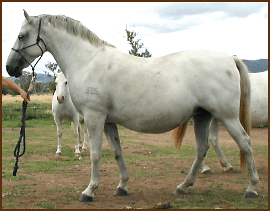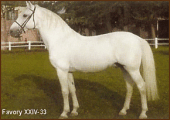
COMMON HORSE BREEDS
| LIPIZZANER
Origin: |
 Photo supplied by the Australian Lipizzaner Registry - NSW © |
History:
In 1580 the Archduke Charles II established a stud farm in Lipizza
breeding the local Karst horses with a selection of superior horses from all
over the world including Spanish Andalusians, Barbs and Berbers,
starting over 400 years of selective breeding. The Karst horses were white in colour,
small, slow to mature, and extremely tough and passed their high
stepping gate on to the modern Lipizzaner.
During the Napoleonic Wars in the late 1700's the horses were moved three times. For a
while Napoleon gained possession of the Lipizzaners and bred his Arabian stallion Vesir to
them. The Kladruby horse helped to develop the Maestoso and the Favoryhe lines from1792 to
1815. From 1807 to 1856 the Arabian stallions Siglavy, Tadmor, Gazlan, Saydan,
Samson, Hadudi, and Ben Azet were used to develop the breed further giving more
lightness and refinement. By 1880 there were 341
Lipizzaner horses at the Lipizza stud farm.
Over the centuries the expansion of the breed had been affected many times by military
conflicts requiring the evacuation of the Lipizza stud. During World War I, the breeding stock was relocated
to Laxenburg near Vienna. After the war central Europe was reorganised with the
breeding stock of the stud farm being divided among three different countries. Only 208
Lipizzaners were known to be left in existence, 109 horses went to Italy. The foals from
1913-1915 remained at Kladrub, then owned by Czechoslovakia. The Republic of Austria
received the rest of the breeding stock and the stallions of the Spanish Riding School in
1919. Breeding of the Lipizzaner had also started in Hungary, Romania, and Yugoslavia. The
existence of the breed was again threatened during World War II. Today the breed is still
considered rare with only approximately 3,000 purebred Lipizzaners in the world, and only
a small number of foals born each year.
Lipizzaners are well known for their floating, eye-catching action and superior movement
to most other breeds. Their natural sense of rhythm helps them to
maintain an even pace without constant adjustments by the rider.
In the 1600's an earthquake and a fire destroyed
the records of the original stud book. Today's pedigrees trace back to 1714. The
Australian Lipizzaner Registry was founded in 1995 to implement the Australian bred
Lipizzaner into the stud book of The Lipizzan International Federation.
Characteristics:
compact, graceful, beautiful, proud bearing
Head: medium length, expressive head; slightly aquiline to
gentle Roman profile; large, open, expressive eyes, good width apart; short, broad ears
Neck: not too heavy, well arched
Shoulders: well sloped
Body: muscular body; soft, broad back, in even length with the neck; strong, medium
width chest; well rounded, not too heavy hindquarters
Legs: sound, heavy bones
Feet: rounded, perfectly shaped
Tail: well carried
Color: born black or bay, slowly turn "white" at
five to eight years of age; are actually grey, a dark skin hidden under a white coat is
only revealed when wet or bears a large scar
Height: stallions 15.2 to 16 hh, mare is 15 to 15.3 hh, not
fully grown until seven years of age
Maturity: at almost 10 years of age
Temperament: easy going, gentle, extremely intelligent,
obedient, desire to please, rider/handler must earn horse's respect
Stallions: extremely gentle, easier
to handle than mares
Mares: a little bossy in a friendly way
Qualities: very adaptable, lovely gait, natural balance,
natural sense of rhythm, quiet and steady under saddle, longevity, stamina, courage
| Today: The Lipizzaner is an excellent all-round riding horse and a successful competitor at all levels of competition in dressage and driving. It is the ultimate horse for classical horsemanship. |
 |
![]()